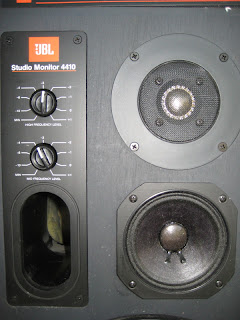After a two year drought and a summer of screaming heat, Austin is evidently now enjoying a fall monsoon, so Speaker Day was at risk this past Sunday. But the sun was sort of out, and the ground was sort of dry, so it was on with the celebration.
The star of the festivities was this bottle:

Yes, that is a really old bottle of Sta-Wax I found at an estate sale. (Guess how much I paid for it.) This stuff has an odd, strong smell, sort of like cherries, but it is a wonderful product. It should be used much like lemon oil, but it is much more effective. It is great on open grain wood like the JBL 4410 it sits on. The photo doesn't do it justice: the right half has been treated and the left half hasn't.
Next up, a classic marriage killer:


This is a Knight 2300C speaker in very lovely dark walnut, or maybe mahogany. If you are the sort of husband who can't bear to leave a pair of large real wood speakers to the hazards of a thrift store, be forewarned. You will be shocked to learn that the wife will not like them. Too honkin' big. But if you do save them from further insult at the hands of barbarians, you will discover they have nice Jensen drivers. The 10" woofer is one of their better finished models, with a horn mid and a very interesting looking tweeter. The crossover is nicely done and worthy of some cap rolling fun and games. Oiled up they look great.
Onward to a long sought after speaker: the Optimus 10. Long ago (as in at least 30 years ago) I read a very nice review on them and thought I would like to give them a listen. Time passed... This is the one an only pair I have ever seen and I literally pulled them out of a huge salvage box at our crazy Goodwill dumping ground. The grill was shattered and the foam surrounds were long gone. I out them back together and even put a nice cap on the tweeter. It is just amazing what a male of the human species will endure for the love of a loudspeaker. The Optimus 10 has a decent dome tweeter with an 8" woofer and a 10" passive radiator. And the tweeter control even has a nice response curve which no doubt is completely accurate. I have yet to give them a real listening, though, I guess I need to find the time after all that effort.


Last on tonight's program is a very sweet EPI 100W, the real walnut veneer variety. I have had a soft spot for these speakers since '74 when I dropped most of a paycheck on a pair with the lovely brass inlays. Peter Frampton sounded great for a week, but then I was burgled, so I have been compensating for that loss ever since.

I neglected to take picture of several other Speaker Day participants, including entries from JBL, Mirage and Heathkit. The next Speaker Day is not that far off, so I better keep that camera warmed up.







